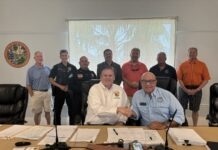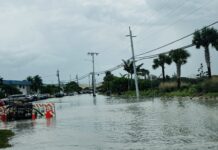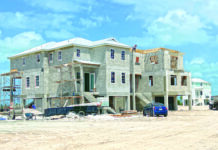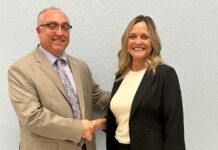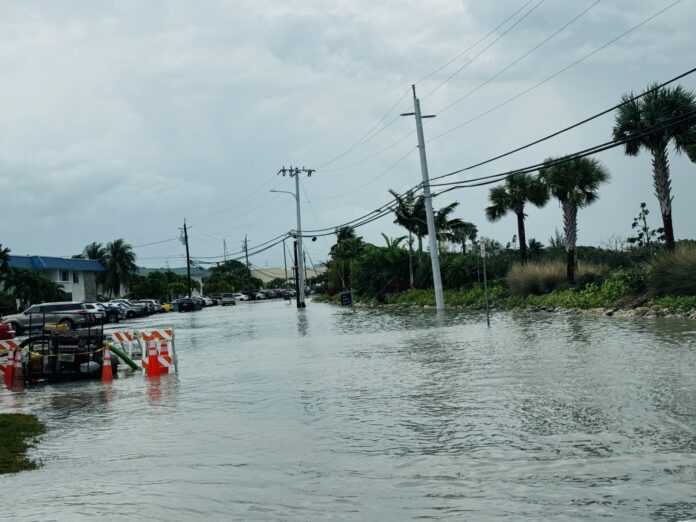
Marathon’s June 25 city council workshop outlined plans underway to alleviate severe flooding along the perennially problematic Sombrero Boulevard – but not without a healthy dose of resident input on the severity of the situation and its culprits.
Plans for the city’s proposed fix to the flooding were previously outlined in a detailed question-and-answer piece with Marathon officials in the June 20 edition of the Marathon Weekly. (To read, scan the attached QR code.) Those plans were explained again Tuesday night, with engineer Steve Suggs of Weiler Engineering describing an upgraded $1 million drainage and pump system estimated for completion in October 2025.
Currently in the permitting stage, the project is expected to be put out for bid by late July, with an award to be voted on by the council in September and construction to begin in October 2024.
Planned features include a raised sidewalk with lighting along the southern edge of Sombrero Boulevard, with a re-graded road designed for water to flow into a drainage apparatus between the road and sidewalk. From there, three pumps will force water down available injection wells at rates upwards of 1,200 gallons per minute each.
Suggs emphasized that the road’s low elevation, the increasing severity of storms and rising tides mean that even the new system will not prevent the road from flooding altogether. “What we can do is try to make it go away faster,” he said. “But I want to be very clear on the expectation that you can’t stop it (from flooding) without raising that entire road, which is a huge undertaking and would affect all the surrounding properties.”
Dockside Boot Key Harbor owner Simone Mullis said the flooding has already caused multiple days of little to no business for her restaurant compared to previous years, and has even forced her to close as conditions became too dangerous for employees to report to work. Using historical sales numbers, she estimated that just two instances of severe flooding cost Dockside an estimated $12,000.
“You’ll never know the proven total cost of what we lost on that particular day,” she said. “I don’t know how many days I can close and lose $5 or $6,000.”
“We’ve had water within inches of coming into condos recently, and we had so much water in our lift station that it was tripping the breaker and causing sewage to start to back up into our condos,” said boulevard resident Robin Rivera. “Who’s going to be responsible for payments for the losses that are starting to be incurred with the flooding? The rain that has been occurring over the past few years has continued to get worse and worse. It’s not just this year.”
Developer Mike Aranda Jr. and charter captain Dave Perry took aim at the project in progress at the Florida Keys Country Club adjacent to the flooding, responsible for a heavily-criticized berm exacerbating stormwater retention along Sombrero Boulevard’s south side.
“What I’m hearing now is that taxpayers are going to pay for (the drainage system),” Aranda said. “When you come to do a development, would it not be reasonable for the taxpayers to ask the city council or staff to ask the developer, ‘Have you done an assessment of the area surrounding it? And if so, how is it going to impact it?’
“I don’t see how in the world you expect taxpayers who had their homes flooded from a guy developing a golf course into a resort to pay for these improvements. It was a catastrophic oversight.”
“(The flooding) has only gotten worse since the property was built up,” Perry said. “I don’t see how the property got built and everybody didn’t have a reasonable doubt of where that water was going to go. I’ve been up and down that road playing golf for 40 years, and I’ve never seen the problems we have now. I want the private people that own the course now to be held responsible.”
Speaking to the Weekly by phone the following morning, Florida Keys Country Club owner Peter Rosasco contended that the slope of the road and impermeable lots across the street had resulted in flooding on his property for years before the berm’s construction.
“This situation has caused harm not only to my neighbors but to my business, and it’s well past time for the city to take steps to correct its problem,” he said. “The city has been well aware of the need to put this utility in for years. I am also anxious and willing to assist the city in any way I can to alleviate this problem, including granting easements to put in this stormwater drainage system.”
Councilman Kenny Matlock and City Attorney Steve Williams discussed the prospect of using LiDAR imaging when approving future projects to predict the stormwater effects of improving previously-vacant lots, a process both said is already widely used in Florida’s mainland counties.
“We’re just getting to that LiDAR technology here in Monroe County, where the mainland has had it for a decade-plus now, and every lot up there requires it,” Williams said. “The short version is that all development down here was done without that benefit.
“All the good lots were built on a long time ago, so what you’re building on now are low-lying lots, but we’re requiring them to be elevated. When you do that, water that used to run off that neighborhood into that low lot … is going other places.”
Planning Director Brian Shea reminded the room that the city recently completed LiDAR imaging for all of Marathon’s roads and has launched an online reporting tool for residents to manually pinpoint areas of problematic flooding. The LiDAR maps and reporting tool may be accessed by scanning the attached QR codes.
At the suggestion of multiple public commenters, Suggs said he would raise the question of the golf course development temporarily accepting water pumped back onto the property while the new drainage system is under construction.
In other news:
- With no formal vote taken, council members agreed that Marathon’s public boat ramps will likely remain open during the recently-announced additional lobster mini-season day on Sunday, July 14. The council directed City Manager George Garrett to explore the possibility of staffing the ramps with additional personnel from the Monroe County Sheriff’s Office, Key Colony Beach Police Department or other contracted agencies.
- The workshop opened with a session led by Shea on using generative A.I. tools to translate residents’ visions for future design standards in Marathon into sample code language. Working in groups, residents collaborated with city staff to describe their ideas for distinct design districts in Marathon and craft corresponding code language for potential inclusion in Land Development Regulation updates. For full coverage, see the July 4 edition of the Marathon Weekly.




